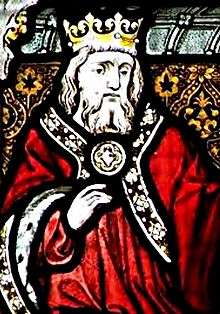Arnulf I, Count of Flanders
| Arnulf I, Count of Flanders | |
|---|---|
 | |
| Born | c. 890 |
| Died | 28 March 965 |
| Noble family | House of Flanders |
| Spouse(s) | Adele of Vermandois |
| Father | Baldwin II of Flanders |
| Mother | Ælfthryth of Wessex |
Arnulf of Flanders (c. 890 – 27 March 965),[1] called the Great, was the first Count of Flanders, who ruled the County of Flanders, an area that is now northern France (Nord), northwestern Belgium and southwestern Netherlands.
Life
Arnulf was the son of margrave Baldwin II of Flanders and Ælfthryth of Wessex, daughter of Alfred the Great.[2] Through his mother he was a descendant of the Anglo-Saxon kings of England, and through his father, a descendant of Charlemagne.[3] Presumably Arnulf was named after Saint Arnulf of Metz, a progenitor of the Carolingian dynasty.[4]
At the death of their father in 918, Arnulf became Count of Flanders while his brother Adeloft or Adelolf succeeded to the County of Boulogne.[2] However, in 933 Adeloft died, and Arnulf took the countship of Boulogne for himself, but later conveyed it to his nephew, Arnulf II.[5]
Arnulf I greatly expanded Flemish rule to the south, taking all or part of Artois, Ponthieu, Amiens, and Ostrevent. He exploited the conflicts between Charles the Simple and Robert I of France, and later those between Louis IV and his barons.
In his southern expansion Arnulf inevitably had conflict with the Normans, who were trying to secure their northern frontier. This led to the 942 murder of the Duke of Normandy, William Longsword, at the hands of Arnulf's men.[6] The Viking threat was receding during the later years of Arnulf's life, and he turned his attentions to the reform of the Flemish government.
Family
The name of Arnulf's first wife is unknown but he had at least one daughter by her:[7]
- Name unknown; married Isaac of Cambrai. Their son Arnulf succeeded his father as Count of Cambrai.[7]
In 934 he married Adele of Vermandois, daughter of Herbert II of Vermandois.[2] Their children were:
- Hildegarde, born c. 934, died 990; she married Dirk II, Count of Holland. It is uncertain whether she is his daughter by his first or second wife.[7]
- Liutgard, born in 935, died in 962; married Wichmann IV, Count of Hamaland.[2]
- Egbert, died 953.[2]
- Baldwin III of Flanders (c. 940 – 962), married Mathilde of Saxony († 1008), daughter of Hermann Billung.[2]
- Elftrude; married Siegfried, Count of Guînes.[2]
Succession
Arnulf made his eldest son and heir Baldwin III of Flanders co-ruler in 958, but Baldwin died untimely in 962, so Arnulf was succeeded by Baldwin's infant son, Arnulf II of Flanders.[2]
Ancestry
| Ancestors of Arnulf I, Count of Flanders | ||||||||||||||||||||||||||||||||||||||||||||||||||||||||||||||||||||||||||||||||||||||||||||||||||||||||||||||||||||||||||||||||||||||||||||||||||||||||||||||||||||||||||||||||||||||||||||||||||||||||||||||||||||||||||||||||||||||||||||||||||||||||||||||||||||||||||||||||||||||||||||||||||||||||||||||||||||||||||||||||||||||||||||||||||||||||||||||||||||||||||||||||||||||||||||||||||||||||||||||||||||||||||||||||||||||||||||||||||||||||||||||||||||||||||||||||||||||||||||||||||||||||||||||||||||||||||||||||||||||||||||||||||||||||||||||||||||||||||||||||
|---|---|---|---|---|---|---|---|---|---|---|---|---|---|---|---|---|---|---|---|---|---|---|---|---|---|---|---|---|---|---|---|---|---|---|---|---|---|---|---|---|---|---|---|---|---|---|---|---|---|---|---|---|---|---|---|---|---|---|---|---|---|---|---|---|---|---|---|---|---|---|---|---|---|---|---|---|---|---|---|---|---|---|---|---|---|---|---|---|---|---|---|---|---|---|---|---|---|---|---|---|---|---|---|---|---|---|---|---|---|---|---|---|---|---|---|---|---|---|---|---|---|---|---|---|---|---|---|---|---|---|---|---|---|---|---|---|---|---|---|---|---|---|---|---|---|---|---|---|---|---|---|---|---|---|---|---|---|---|---|---|---|---|---|---|---|---|---|---|---|---|---|---|---|---|---|---|---|---|---|---|---|---|---|---|---|---|---|---|---|---|---|---|---|---|---|---|---|---|---|---|---|---|---|---|---|---|---|---|---|---|---|---|---|---|---|---|---|---|---|---|---|---|---|---|---|---|---|---|---|---|---|---|---|---|---|---|---|---|---|---|---|---|---|---|---|---|---|---|---|---|---|---|---|---|---|---|---|---|---|---|---|---|---|---|---|---|---|---|---|---|---|---|---|---|---|---|---|---|---|---|---|---|---|---|---|---|---|---|---|---|---|---|---|---|---|---|---|---|---|---|---|---|---|---|---|---|---|---|---|---|---|---|---|---|---|---|---|---|---|---|---|---|---|---|---|---|---|---|---|---|---|---|---|---|---|---|---|---|---|---|---|---|---|---|---|---|---|---|---|---|---|---|---|---|---|---|---|---|---|---|---|---|---|---|---|---|---|---|---|---|---|---|---|---|---|---|---|---|---|---|---|---|---|---|---|---|---|---|---|---|---|---|---|---|---|---|---|---|---|---|---|---|---|---|---|---|---|---|---|---|---|---|---|---|---|---|---|---|---|---|---|---|---|---|---|---|---|---|---|---|---|---|---|---|---|---|---|---|---|---|---|---|---|---|---|---|---|---|---|---|---|---|---|---|---|---|---|---|---|---|---|---|---|---|---|---|---|---|---|---|---|---|---|---|---|---|---|---|---|---|---|---|---|---|---|---|---|---|---|---|---|---|---|---|---|---|---|---|---|---|---|---|---|---|---|---|---|---|---|---|---|---|---|---|---|---|---|---|---|---|---|---|---|---|---|---|---|---|---|---|---|---|---|---|---|---|---|---|---|---|---|---|---|---|---|---|---|---|---|---|---|---|---|---|---|---|---|---|---|---|
| ||||||||||||||||||||||||||||||||||||||||||||||||||||||||||||||||||||||||||||||||||||||||||||||||||||||||||||||||||||||||||||||||||||||||||||||||||||||||||||||||||||||||||||||||||||||||||||||||||||||||||||||||||||||||||||||||||||||||||||||||||||||||||||||||||||||||||||||||||||||||||||||||||||||||||||||||||||||||||||||||||||||||||||||||||||||||||||||||||||||||||||||||||||||||||||||||||||||||||||||||||||||||||||||||||||||||||||||||||||||||||||||||||||||||||||||||||||||||||||||||||||||||||||||||||||||||||||||||||||||||||||||||||||||||||||||||||||||||||||||||
See also
References
| Wikimedia Commons has media related to Arnulf I of Flanders. |
- ↑ H. E. L. Mellersh; Neville Williams (1999). Chronology of World History. ABC-CLIO. ISBN 978-1-57607-155-7.
- 1 2 3 4 5 6 7 8 Detlev Schwennicke, Europäische Stammtafeln: Stammtafeln zur Geschichte der Europäischen Staaten, Neue Folge, Band II (Verlag von J. A. Stargardt, Marburg, Germany, 1984), Tafel 5
- ↑ The Annals of Flodoard of Reims, 919–966, ed. Steven Fanning & Bernard S. Bachrach (University of Toronto Press, CA, 2011), p. xx
- ↑ Philip Grierson, 'The Relations between England and Flanders before the Norman Conquest', Transactions of the Royal Historical Society, Vol. 23 (1941), p. 86 n. 1
- ↑ Renée Nip, 'The Political Relations between England and Flanders (1066–1128)', Anglo-Norman Studies 21: Proceedings of the Battle Conference 1998, ed. Christopher Harper-Bill (The Boydell Press, Woodbridge, UK, 1999), p. 150
- ↑ David Nicholas, Medieval Flanders (Longman Group UK Limited, London, 1992), p. 40
- 1 2 3 Heather J. Tanner, Families, Friends and Allies: Boulogne and Politics in Northern France and England, C.879–1160 (Brill, Leiden, Netherlands, 2004) p. 55 n. 143
Additional references
- Folcwine
- Lambert of Ardres
- Platts, Beryl. The Scottish Hazard: Flemish Nobility and their Impact on Scotland, 1985
| Preceded by Baldwin II |
918–965 with Baldwin III (958–962) |
Succeeded by Arnulf II (Flanders) |
| Preceded by Adalolphe |
Count of Boulogne 933–964 |
Succeeded by Arnulf II (Boulogne) |